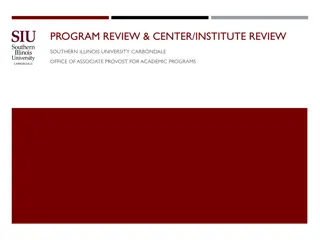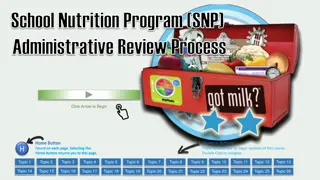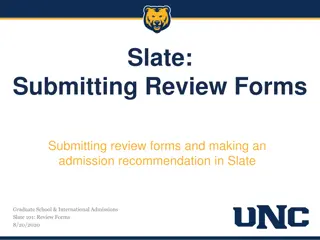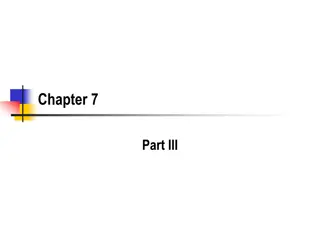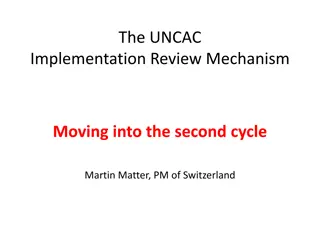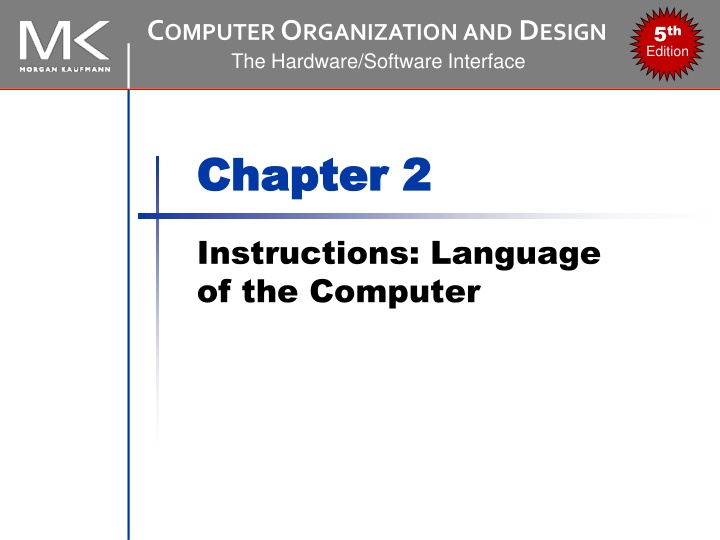
Computer Organization and Design: Chapter 2 Instructions Language
Explore Chapter 2 "Instructions: Language of the Computer" from the book "Computer Organization and Design: The Hardware/Software Interface 5th Edition." Learn about instruction sets, the MIPS Instruction Set, computer hardware operations, arithmetic examples, and operands in computer hardware.
Download Presentation

Please find below an Image/Link to download the presentation.
The content on the website is provided AS IS for your information and personal use only. It may not be sold, licensed, or shared on other websites without obtaining consent from the author. If you encounter any issues during the download, it is possible that the publisher has removed the file from their server.
You are allowed to download the files provided on this website for personal or commercial use, subject to the condition that they are used lawfully. All files are the property of their respective owners.
The content on the website is provided AS IS for your information and personal use only. It may not be sold, licensed, or shared on other websites without obtaining consent from the author.
E N D
Presentation Transcript
COMPUTER ORGANIZATIONAND DESIGN The Hardware/Software Interface 5th Edition Chapter 2 Chapter 2 Instructions: Language of the Computer
2.1 Introduction Instruction Set The repertoire of instructions of a computer Different computers have different instruction sets But with many aspects in common Early computers had very simple instruction sets Simplified implementation Many modern computers also have simple instruction sets Chapter 2 Instructions: Language of the Computer 2
The MIPS Instruction Set Used as the example throughout the book Stanford MIPS commercialized by MIPS Technologies (www.mips.com) Large share of embedded core market Applications in consumer electronics, network/storage equipment, cameras, printers, Typical of many modern ISAs See MIPS Reference Data tear-out card, and Appendixes B and E Chapter 2 Instructions: Language of the Computer 3
2.2 Operations of the Computer Hardware Arithmetic Operations Add and subtract, three operands Two sources and one destination add a, b, c # a gets b + c All arithmetic operations have this form Design Principle 1: Simplicity favours regularity Regularity makes implementation simpler Simplicity enables higher performance at lower cost Chapter 2 Instructions: Language of the Computer 4
Arithmetic Example C code: f = (g + h) - (i + j); Compiled MIPS code: add t0, g, h # temp t0 = g + h add t1, i, j # temp t1 = i + j sub f, t0, t1 # f = t0 - t1 Chapter 2 Instructions: Language of the Computer 5
2.3 Operands of the Computer Hardware Register Operands Arithmetic instructions use register operands MIPS has a 32 32-bit register file Use for frequently accessed data Numbered 0 to 31 32-bit data called a word Assembler names $t0, $t1, , $t9 for temporary values $s0, $s1, , $s7 for saved variables Design Principle 2: Smaller is faster c.f. main memory: millions of locations Chapter 2 Instructions: Language of the Computer 6
Register Operand Example C code: f = (g + h) - (i + j); f, , j in $s0, , $s4 Compiled MIPS code: add $t0, $s1, $s2 add $t1, $s3, $s4 sub $s0, $t0, $t1 Chapter 2 Instructions: Language of the Computer 7
Memory Operands Main memory used for composite data Arrays, structures, dynamic data To apply arithmetic operations Load values from memory into registers Store result from register to memory Memory is byte addressed Each address identifies an 8-bit byte Words are aligned in memory Address must be a multiple of 4 MIPS is Big Endian Most-significant byte at least address of a word c.f. Little Endian: least-significant byte at least address Chapter 2 Instructions: Language of the Computer 8
Memory Operand Example 1 C code: g = h + A[8]; g in $s1, h in $s2, base address of A in $s3 Compiled MIPS code: Index 8 requires offset of 32 4 bytes per word lw $t0, 32($s3) # load word add $s1, $s2, $t0 offset base register Chapter 2 Instructions: Language of the Computer 9
Memory Operand Example 2 C code: A[12] = h + A[8]; h in $s2, base address of A in $s3 Compiled MIPS code: Index 8 requires offset of 32 lw $t0, 32($s3) # load word add $t0, $s2, $t0 sw $t0, 48($s3) # store word Chapter 2 Instructions: Language of the Computer 10
Registers vs. Memory Registers are faster to access than memory Operating on memory data requires loads and stores More instructions to be executed Compiler must use registers for variables as much as possible Only spill to memory for less frequently used variables Register optimization is important! Chapter 2 Instructions: Language of the Computer 11
Immediate Operands Constant data specified in an instruction addi $s3, $s3, 4 No subtract immediate instruction Just use a negative constant addi $s2, $s1, -1 Design Principle 3: Make the common case fast Small constants are common Immediate operand avoids a load instruction Chapter 2 Instructions: Language of the Computer 12
The Constant Zero MIPS register 0 ($zero) is the constant 0 Cannot be overwritten Useful for common operations E.g., move between registers add $t2, $s1, $zero Chapter 2 Instructions: Language of the Computer 13
2.6 Logical Operations Logical Operations Instructions for bitwise manipulation Operation Shift left Shift right Bitwise AND Bitwise OR Bitwise NOT C << >> & | ~ Java << >>> & | ~ MIPS sll srl and, andi or, ori nor Useful for extracting and inserting groups of bits in a word Chapter 2 Instructions: Language of the Computer 14
Shift Operations op rs rt rd shamt funct 6 bits 5 bits 5 bits 5 bits 5 bits 6 bits shamt: how many positions to shift Shift left logical Shift left and fill with 0 bits sll by i bits multiplies by 2i Shift right logical Shift right and fill with 0 bits srl by i bits divides by 2i (unsigned only) Chapter 2 Instructions: Language of the Computer 15
AND Operations Useful to mask bits in a word Select some bits, clear others to 0 and $t0, $t1, $t2 $t2 0000 0000 0000 0000 0000 1101 1100 0000 $t1 0000 0000 0000 0000 0011 1100 0000 0000 $t0 0000 0000 0000 0000 0000 1100 0000 0000 Chapter 2 Instructions: Language of the Computer 16
OR Operations Useful to include bits in a word Set some bits to 1, leave others unchanged or $t0, $t1, $t2 $t2 0000 0000 0000 0000 0000 1101 1100 0000 $t1 0000 0000 0000 0000 0011 1100 0000 0000 $t0 0000 0000 0000 0000 0011 1101 1100 0000 Chapter 2 Instructions: Language of the Computer 17
NOT Operations Useful to invert bits in a word Change 0 to 1, and 1 to 0 MIPS has NOR 3-operand instruction a NOR b == NOT ( a OR b ) nor $t0, $t1, $zero Register 0: always read as zero $t1 0000 0000 0000 0000 0011 1100 0000 0000 $t0 1111 1111 1111 1111 1100 0011 1111 1111 Chapter 2 Instructions: Language of the Computer 18
2.7 Instructions for Making Decisions Conditional Operations Branch to a labeled instruction if a condition is true Otherwise, continue sequentially beq rs, rt, L1 if (rs == rt) branch to instruction labeled L1; bne rs, rt, L1 if (rs != rt) branch to instruction labeled L1; j L1 unconditional jump to instruction labeled L1 Chapter 2 Instructions: Language of the Computer 19
Compiling If Statements C code: if (i==j) f = g+h; else f = g-h; f, g, in $s0, $s1, Compiled MIPS code: bne $s3, $s4, Else add $s0, $s1, $s2 j Exit Else: sub $s0, $s1, $s2 Exit: Assembler calculates addresses Chapter 2 Instructions: Language of the Computer 20
Compiling Loop Statements C code: while (save[i] == k) i += 1; i in $s3, k in $s5, address of save in $s6 Compiled MIPS code: Loop: sll $t1, $s3, 2 add $t1, $t1, $s6 lw $t0, 0($t1) bne $t0, $s5, Exit addi $s3, $s3, 1 j Loop Exit: Chapter 2 Instructions: Language of the Computer 21
Basic Blocks A basic block is a sequence of instructions with No embedded branches (except at end) No branch targets (except at beginning) A compiler identifies basic blocks for optimization An advanced processor can accelerate execution of basic blocks Chapter 2 Instructions: Language of the Computer 22
More Conditional Operations Set result to 1 if a condition is true Otherwise, set to 0 slt rd, rs, rt if (rs < rt) rd = 1; else rd = 0; slti rt, rs, constant if (rs < constant) rt = 1; else rt = 0; Use in combination with beq, bne slt $t0, $s1, $s2 # if ($s1 < $s2) bne $t0, $zero, L # branch to L Chapter 2 Instructions: Language of the Computer 23
Branch Instruction Design Why not blt, bge, etc? Hardware for <, , slower than =, Combining with branch involves more work per instruction, requiring a slower clock All instructions penalized! beq and bne are the common case This is a good design compromise Chapter 2 Instructions: Language of the Computer 24
2.8 Supporting Procedures in Computer Hardware Procedure Calling Steps required 1. Place parameters in registers 2. Transfer control to procedure 3. Acquire storage for procedure 4. Perform procedure s operations 5. Place result in register for caller 6. Return to place of call Chapter 2 Instructions: Language of the Computer 25
Register Usage $a0 $a3: arguments (reg s 4 7) $v0, $v1: result values (reg s 2 and 3) $t0 $t9: temporaries Can be overwritten by callee $s0 $s7: saved Must be saved/restored by callee $gp: global pointer for static data (reg 28) $sp: stack pointer (reg 29) $fp: frame pointer (reg 30) $ra: return address (reg 31) Chapter 2 Instructions: Language of the Computer 26
Procedure Call Instructions Procedure call: jump and link jal ProcedureLabel Address of following instruction put in $ra Jumps to target address Procedure return: jump register jr $ra Copies $ra to program counter Can also be used for computed jumps e.g., for case/switch statements Chapter 2 Instructions: Language of the Computer 27
Leaf Procedure Example C code: int leaf_example (int g, h, i, j) { int f; f = (g + h) - (i + j); return f; } Arguments g, , j in $a0, , $a3 f in $s0 (hence, need to save $s0 on stack) Result in $v0 Chapter 2 Instructions: Language of the Computer 28
Leaf Procedure Example MIPS code: leaf_example: addi $sp, $sp, -4 sw $s0, 0($sp) add $t0, $a0, $a1 add $t1, $a2, $a3 sub $s0, $t0, $t1 add $v0, $s0, $zero lw $s0, 0($sp) addi $sp, $sp, 4 jr $ra Save $s0 on stack Procedure body Result Restore $s0 Return Chapter 2 Instructions: Language of the Computer 29
Non-Leaf Procedures Procedures that call other procedures For nested call, caller needs to save on the stack: Its return address Any arguments and temporaries needed after the call Restore from the stack after the call Chapter 2 Instructions: Language of the Computer 30
Non-Leaf Procedure Example C code: int fact (int n) { if (n < 1) return f; else return n * fact(n - 1); } Argument n in $a0 Result in $v0 Chapter 2 Instructions: Language of the Computer 31
Non-Leaf Procedure Example MIPS code: fact: addi $sp, $sp, -8 # adjust stack for 2 items sw $ra, 4($sp) # save return address sw $a0, 0($sp) # save argument slti $t0, $a0, 1 # test for n < 1 beq $t0, $zero, L1 addi $v0, $zero, 1 # if so, result is 1 addi $sp, $sp, 8 # pop 2 items from stack jr $ra # and return L1: addi $a0, $a0, -1 # else decrement n jal fact # recursive call lw $a0, 0($sp) # restore original n lw $ra, 4($sp) # and return address addi $sp, $sp, 8 # pop 2 items from stack mul $v0, $a0, $v0 # multiply to get result jr $ra # and return Chapter 2 Instructions: Language of the Computer 32
Local Data on the Stack Local data allocated by callee e.g., C automatic variables Procedure frame (activation record) Used by some compilers to manage stack storage Chapter 2 Instructions: Language of the Computer 33
Memory Layout Text: program code Static data: global variables e.g., static variables in C, constant arrays and strings $gp initialized to address allowing offsets into this segment Dynamic data: heap E.g., malloc in C, new in Java Stack: automatic storage Chapter 2 Instructions: Language of the Computer 34
Branch Addressing Branch instructions specify Opcode, two registers, target address Most branch targets are near branch Forward or backward op rs rt constant or address 6 bits 5 bits 5 bits 16 bits PC-relative addressing Target address = PC + offset 4 PC already incremented by 4 by this time Chapter 2 Instructions: Language of the Computer 35
Jump Addressing Jump (j and jal) targets could be anywhere in text segment Encode full address in instruction op address 26 bits 6 bits (Pseudo)Direct jump addressing Target address = PC31 28 : (address 4) Chapter 2 Instructions: Language of the Computer 36
Target Addressing Example Loop code from earlier example Assume Loop at location 80000 80000 0 0 19 9 4 0 Loop: sll $t1, $s3, 2 80004 0 9 22 9 0 32 add $t1, $t1, $s6 80008 35 9 8 0 lw $t0, 0($t1) 80012 5 8 21 2 bne $t0, $s5, Exit 80016 8 19 19 1 addi $s3, $s3, 1 80020 2 20000 j Loop 80024 Exit: Chapter 2 Instructions: Language of the Computer 37
Branching Far Away If branch target is too far to encode with 16-bit offset, assembler rewrites the code Example beq $s0,$s1, L1 bne $s0,$s1, L2 j L1 L2: Chapter 2 Instructions: Language of the Computer 38
Addressing Mode Summary Chapter 2 Instructions: Language of the Computer 39
2.11 Parallelism and Instructions: Synchronization Synchronization Two processors sharing an area of memory P1 writes, then P2 reads Data race if P1 and P2 don t synchronize Result depends of order of accesses Hardware support required Atomic read/write memory operation No other access to the location allowed between the read and write Could be a single instruction E.g., atomic swap of register Or an atomic pair of instructions memory Chapter 2 Instructions: Language of the Computer 40
Synchronization in MIPS Load linked: ll rt, offset(rs) Store conditional: sc rt, offset(rs) Succeeds if location not changed since the ll Returns 1 in rt Fails if location is changed Returns 0 in rt Example: atomic swap (to test/set lock variable) try: add $t0,$zero,$s4 ;copy exchange value ll $t1,0($s1) ;load linked sc $t0,0($s1) ;store conditional beq $t0,$zero,try ;branch store fails add $s4,$zero,$t1 ;put load value in $s4 Chapter 2 Instructions: Language of the Computer 41
2.12 Translating and Starting a Program Translation and Startup Many compilers produce object modules directly Static linking Chapter 2 Instructions: Language of the Computer 42
Producing an Object Module Assembler (or compiler) translates program into machine instructions Provides information for building a complete program from the pieces Header: described contents of object module Text segment: translated instructions Static data segment: data allocated for the life of the program Relocation info: for contents that depend on absolute location of loaded program Symbol table: global definitions and external refs Debug info: for associating with source code Chapter 2 Instructions: Language of the Computer 43
Linking Object Modules Produces an executable image 1. Merges segments 2. Resolve labels (determine their addresses) 3. Patch location-dependent and external refs Could leave location dependencies for fixing by a relocating loader But with virtual memory, no need to do this Program can be loaded into absolute location in virtual memory space Chapter 2 Instructions: Language of the Computer 44
Loading a Program Load from image file on disk into memory 1. Read header to determine segment sizes 2. Create virtual address space 3. Copy text and initialized data into memory Or set page table entries so they can be faulted in 4. Set up arguments on stack 5. Initialize registers (including $sp, $fp, $gp) 6. Jump to startup routine Copies arguments to $a0, and calls main When main returns, do exit syscall Chapter 2 Instructions: Language of the Computer 45
Dynamic Linking Only link/load library procedure when it is called Requires procedure code to be relocatable Avoids image bloat caused by static linking of all (transitively) referenced libraries Automatically picks up new library versions Chapter 2 Instructions: Language of the Computer 46
Lazy Linkage Indirection table Stub: Loads routine ID, Jump to linker/loader Linker/loader code Dynamically mapped code Chapter 2 Instructions: Language of the Computer 47
Starting Java Applications Simple portable instruction set for the JVM Compiles bytecodes of hot methods into native code for host machine Interprets bytecodes Chapter 2 Instructions: Language of the Computer 48
Effect of Compiler Optimization Compiled with gcc for Pentium 4 under Linux Relative Performance 140000 Instruction count 3 120000 2.5 100000 2 80000 1.5 60000 1 40000 0.5 20000 0 0 none O1 O2 O3 none O1 O2 O3 CPI Clock Cycles 180000 2 160000 140000 1.5 120000 100000 1 80000 60000 0.5 40000 20000 0 0 none O1 O2 O3 none O1 O2 O3 Chapter 2 Instructions: Language of the Computer 49
Effect of Language and Algorithm Bubblesort Relative Performance 3 2.5 2 1.5 1 0.5 0 C/none C/O1 C/O2 C/O3 Java/int Java/JIT Quicksort Relative Performance 2.5 2 1.5 1 0.5 0 C/none C/O1 C/O2 C/O3 Java/int Java/JIT Quicksort vs. Bubblesort Speedup 3000 2500 2000 1500 1000 500 0 C/none C/O1 C/O2 C/O3 Java/int Java/JIT Chapter 2 Instructions: Language of the Computer 50














